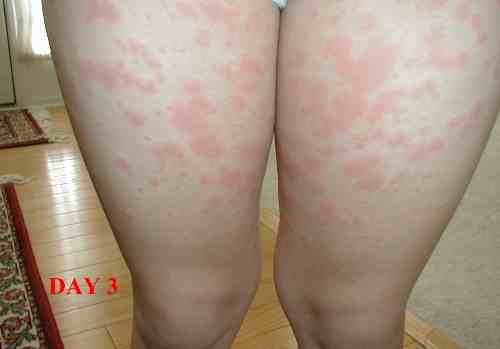Cathy& phillip
New
- Messages
- 5
- Reaction score
- 0
- Points
- 0
Does anyone know what a lamictal rash looks like?
Welcome to the Coping With Epilepsy forums - a peer support community for folks dealing (directly or indirectly) with seizure disorders. You can visit the forum page to see the list of forum nodes (categories/rooms) for topics.
Please have a look around and if you like what you see, please consider registering an account and joining the discussions. When you register an account and log in, you may enjoy additional benefits including no ads, access to members only (ie. private) forum nodes and more. Registering an account is free - you have nothing to lose!
Lamictal Rash
Not all rashes with Lamictal are dangerous; however, sometimes the drug can cause a more serious rash. In studies, about 0.8 percent of children (and up to 0.3 percent of adults) taking the drug experienced a rash that was severe enough to require hospitalization. The best way to prevent a life-threatening rash is to follow your healthcare provider's dosing instructions and report any rash immediately.
Lamictal Rash: An Introduction
Lamictal® (lamotrigine) is a prescription medication used to treat epilepsy and bipolar disorder (also known as manic depression). In rare cases, Lamictal can cause life-threatening skin rashes.
Life-Threatening Rashes With Lamictal
You may be wondering how a skin rash can be life-threatening. While most rashes are merely bothersome, some can be dangerous. Stevens-Johnson syndrome (SJS) and toxic epidermal necrolysis (TEN) are rare types of rashes that can be fatal. They can cause large sections of the skin to die, which can lead to disfigurement or dangerous infections. As many as 40 percent of people with toxic epidermal necrolysis (which is more severe than Stevens-Johnson syndrome) will die as a result of the condition.
Stevens-Johnson syndrome and toxic epidermal necrolysis are most often caused by medications, including Lamictal.
How Common Is a Dangerous Lamictal Rash?
In studies of Lamictal in children, 16 out of 1,983 children (about 0.8 percent) experienced a rash that was severe enough to require hospitalization. One of these children died as a result of the rash. Children taking Lamictal with divalproex (Depakote®, Depakote ER®) or valproic acid (Depakene®) were at a higher risk, with about 1.2 percent of these children experiencing a dangerous rash.
In adults, a dangerous Lamictal rash seems to be a little less common. Up to 0.3 percent of adults taking the drug developed a rash that required hospitalization. The rashes were less common in people taking it for bipolar disorder and were more likely in people taking Lamictal for epilepsy. Just like with children, combining Lamictal with divalproex (Depakote, Depakote ER) or valproic acid (Depakene) increased the risk of serious rashes (up to 1 percent).
Signs of a Dangerous Rash
Not all rashes seen with Lamictal use are dangerous. However, it is impossible to tell if a rash will be dangerous or not, regardless of how long you have been taking Lamictal. You should tell your healthcare provider immediately if you notice any rash while taking the drug, as any rash could potentially be life-threatening. Talking to your healthcare provider as soon as possible (and stopping Lamictal, if necessary) may help limit the severity of the rash.
Can Rashes With Lamictal Be Prevented?
It has been suggested that taking more than the recommended starting Lamictal dosage may increase your risk of a dangerous Lamictal rash. Also, it is thought that increasing your dose too quickly or combining Lamictal with divalproex (Depakote, Depakote ER) or valproic acid (Depakene) may also increase your risk.
The best way to prevent a life-threatening rash with Lamictal is to carefully follow your healthcare provider's dosing instructions and tell him or her about any rash as soon as possible. Do not take more Lamictal than your healthcare provider recommends, and be sure you understand exactly how to increase your dose. If you have stopped taking the drug for a while (even just a few days), talk to your healthcare provider, as you may need to start back at a lower dosage.
Here is one example of a Lamictal rash:

